Albert Alvarez (b. 1983), a San Antonio-based artist, is an obsessive depicter of everyday apocalypses. He produces a doom-laden drawing every couple of days, and he sells them almost as fast as he makes them. His paintings, which are generally larger and more complex, sometimes take months to complete. Due to the gallery closures and general lockdowns caused by the COVID-19 pandemic, Alvarez — most uncharacteristically — obsessively reworked some completed paintings that remained hanging on his studio walls. Fittingly, one of them, titled Thus, Death Came Through the Windows, depicts the Bubonic plague. Thus, Alvarez obsessed on a plague painting during an actual plague.
Alvarez habitually depicts marginalized communities that subsist in the shadows of American affluence. Theirs is a desperate existence, hemmed in by poverty, violence, and redlined urban structures designed to contain them. In this world, windows are always broken, the environment is degraded, the strong prey on the weak, weapons menace even casual passersby, people sell themselves for a drink or a fix, life is a parade of follies, and danger, disease, and degradation await the weary at every turn. The barrio is always being transformed into a living hell, and Alvarez depicts the eves of countless destructions. Armageddon is close at hand — sometimes, as manifested by falling missiles or mushroom clouds — it has already begun.
Alvarez’s bleak perspective is so “medieval,” so deeply impacted by artists such as Bruegel and Bosch, that its transposition to a medieval plague scene requires only a change of wardrobe. Yet, despite the change of clothes and scenery, Alvarez is also painting the present. As always, Alvarez is indebted to the work of Joe Coleman. Though Coleman attended SVA for two years and Alvarez graduated from RISD, both regard themselves as self-taught, outsider artists.
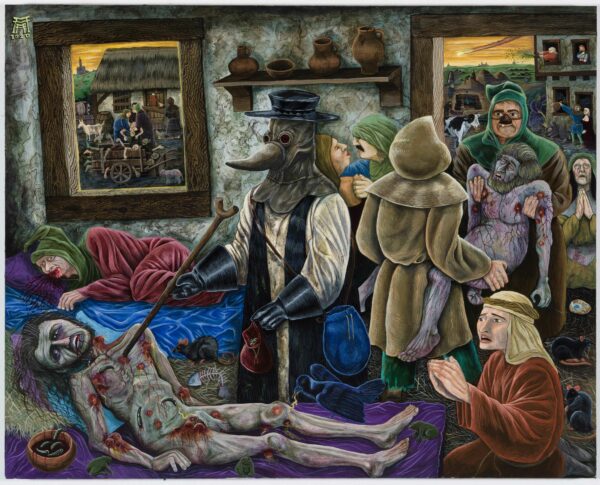
Albert Alvarez, “Thus, Death Came Through the Windows,” 2020 state, acrylic on panel, 16 x 20 inches. Collection of Phil Arevalo. Photograph: Ansen Seale.
The first state of Alvarez’s painting was executed during the first stage of the COVID-19 pandemic, when there was still uncertainty about the means of its transmission: people were obsessively washing their hands and food packaging, unaware that the virus was primarily transmitted via aerosol. There were no effective treatments or vaccines.
A modern doctor — like the plague doctor Alvarez depicts — had very limited means to fight the COVID-19 pandemic in its early days. (But at least patients weren’t subject to appalling, pre-modern treatments.) Tragically, like many of the medieval workers who tended to the sick and buried the dead, many front-line medical workers contracted COVID-19 and died.
Alvarez’s tableau is set in a geographically unspecified European hovel meant to evoke the Black Death’s most deadly phase, which lasted from 1347-1352. Two members of a family are in bed. The man in the left foreground is laid out like a dead Christ ready to be wrapped for burial. He has been bled with leeches — several of which are still crawling on his body.
The three toads on the bed refer to treatments for the plague, one of which was to wear a necklace of desiccated toads to draw out the diseased “vapors.” Isaac Newton subsequently had a more complex formulation that involved suspending a toad “by the legs in a chimney for three days, which at last vomited up earth with various insects in it… and shortly after died.” Then one should grind the toad and the excretions and wear this compound around the neck to draw out the poisons. Fortunately, while Cambridge University was closed down in 1666, Newton used his plague-mandated sabbatical to define the laws of gravity, rather than to test toad cures.
The London Pharmocopoeia (1618) by the College of Physicians recommended defeathering a pigeon, then pressing the bald spot to the plague sore until the pigeon died, “and by this means draw out the poison.” The pecking crow in Alvarez’s painting is also drawing out the poison. Medical ingenuity was limited to prayer and to sucking, absorbing, or pecking out the deadly toxins.
None of these treatments — which predated the germ theory of disease — were effective. We moderns, of course, are not without quackery, including ineffective COVID-19 self-cure treatments, such as hydroxychloroquine and ivermectin. Nor should we forget that in 2020 President Trump advocated injecting disinfectants (“because you see it gets in the lungs and it does a tremendous number on the lungs”) and the administration of UV light or “powerful light…. inside the body” where “it kills it [COVID-19] in one minute — that’s pretty powerful.”
While the praying woman in the lower right corner of Alvarez’s pictures endows the painting with a pieta-like quality, the plague doctor in his bird suit pokes a plague pustule with his cane. His other hand attends to his bag of coins.
According to John Frith, the plague suit was utilized in the 15th and 16th centuries, though many accounts favor a later date. By stuffing the beak area with herbs and flowers, doctors futilely attempted to counter the miasma (bad air) that was thought to cause the plague. The main culprit, instead, was bites from infected fleas, typically carried by rats. So the bird suit wasn’t especially effective, though it did cut down on contact with infected tissue and did help a little against droplets from sneezing patients. Modern medical workers are much better off in their layers of disposable personal protective equipment, which is a sanitary successor to the plague doctor’s suit.
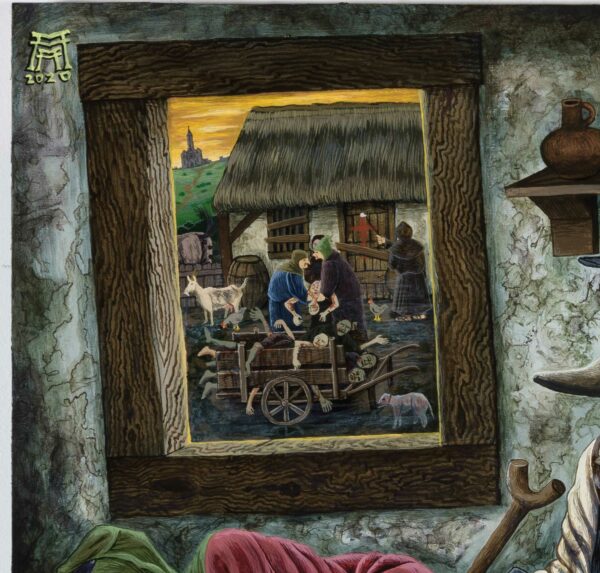
Albert Alvarez, “Thus, Death Came Through the Windows” (detail of window), 2020 state, acrylic on panel, 16 x 20 inches. Collection of Phil Arevalo. Photograph: Ansen Seale.
Now let us consider the two views outside of the hovel. In the upper left, the thick, wooden window frame is like a rustic picture frame, only this really is a “window on the world,” and that world isn’t a pretty sight. Three monks are loading bodies into a cart, while another adds to a cross on a barricaded door that marks quarantine.
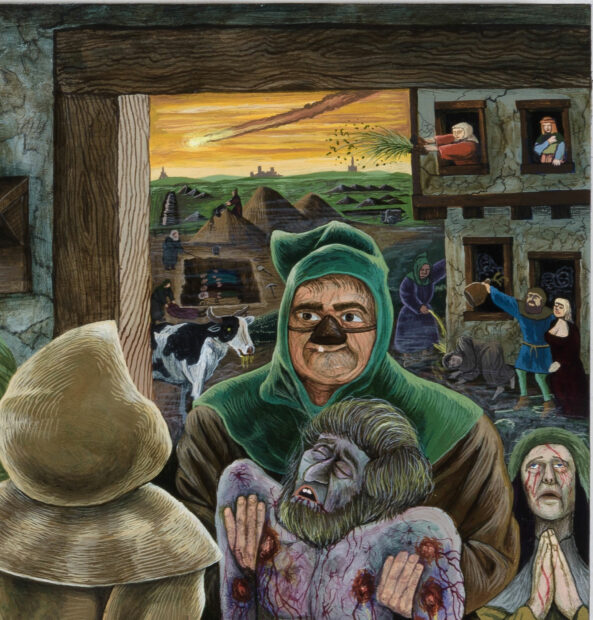
Albert Alvarez, “Thus, Death Came Through the Windows” (detail of open doorway), 2020 state, acrylic on panel, 16 x 20 inches. Collection of Phil Arevalo. Photograph: Ansen Seale.
In the upper right, two monks carry out a naked corpse while a woman prays, evoking images of depositions of Christ. But this body is headed for the mass graves in the distance rather than a stone tomb. Three peaked piles of dirt evoke the pyramids of Egypt and emphasize the scale of these evacuations. In the top right, a buxom woman and a man with a big jug are about to cavort at an inn. Pestilence be damned, say they, as medieval equivalents of our contemporaries who objected to the closure of bars and beauty salons. In Alvarez’s pictorial universe, sex is as inevitable as death — even in the very face of mass death.
A man has partied too hard and is passed out at their feet. In the upper story, a blond woman displays herself in a window, ready to take on all comers. Meanwhile, another woman empties a chamber pot, which spews deadly bacteria into the atmosphere.
A comet — frequently interpreted as a sign of divine punishment or as a harbinger of the end of days — streaks across the sky. In Alvarez’s art, it is an archaic equivalent of a nuclear missile.
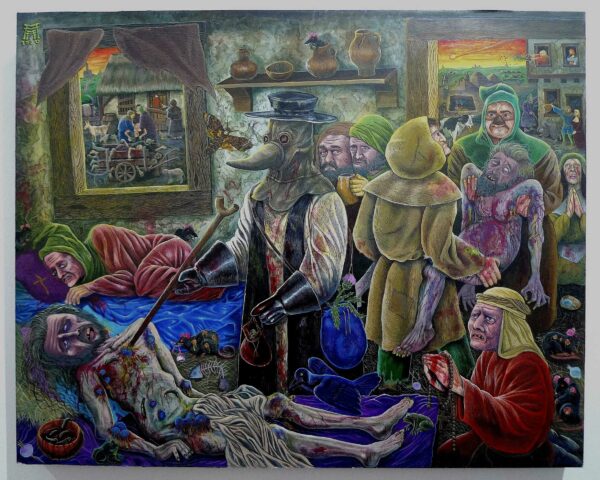
Albert Alvarez, “Thus, Death Came Through the Windows,” 2022 state, acrylic on panel, 16 x 20 inches. Collection of Phil Arevalo. Photograph: author.
In the final version of the painting, which was exhibited in August at Un Grito, a gallery in San Antonio’s Blue Star Arts Complex, Alvarez has added blood to several figures. This includes the two dead men, the doctor, and the hands of the woman in the right foreground, who now grasps a rosary. The other bedridden figure has a small wooden cross on his pillow. Nothing brings out religion like a plague, whether it be bubonic or AIDS.
The rats have proliferated, doubling in number from three to six, several of which sport ghastly sores of their own. When they die, their fleas will seek new hosts. Bulbs of garlic — that most apotropaic herb — are generously scattered about.
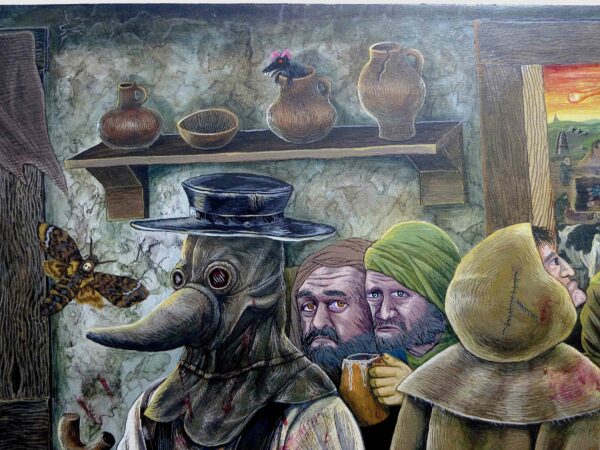
Albert Alvarez, “Thus, Death Came Through the Windows” (detail with skull-headed moth), 2022 state, acrylic on panel, 16 x 20 inches. Collection of Phil Arevalo. Photograph: author.
Alvarez’s most interesting addition is a skull-headed moth, which is about to alight on the plague doctor’s futile beak. It will serve as a fitting perch for the symbol of the death that will consume all the creatures in Thus, Death Came Through the Windows.
****
Ruben C. Cordova is an art historian and a curator who is preparing a three part study of Alvarez’s work for Glasstire.


